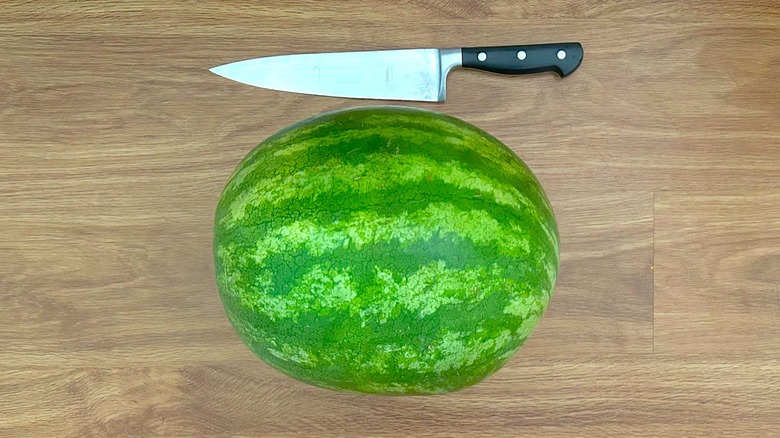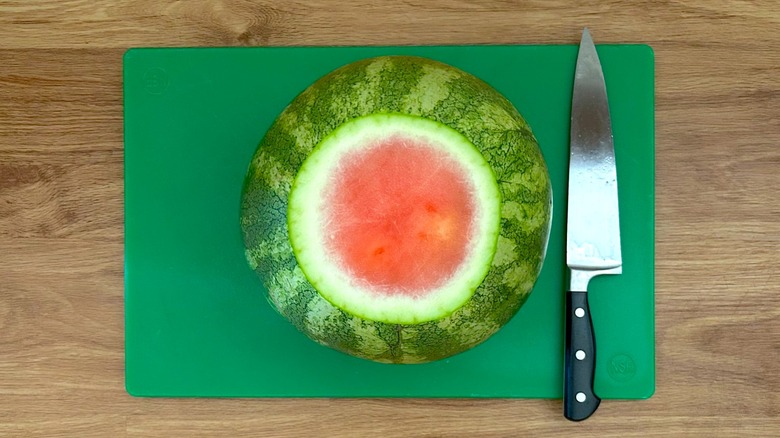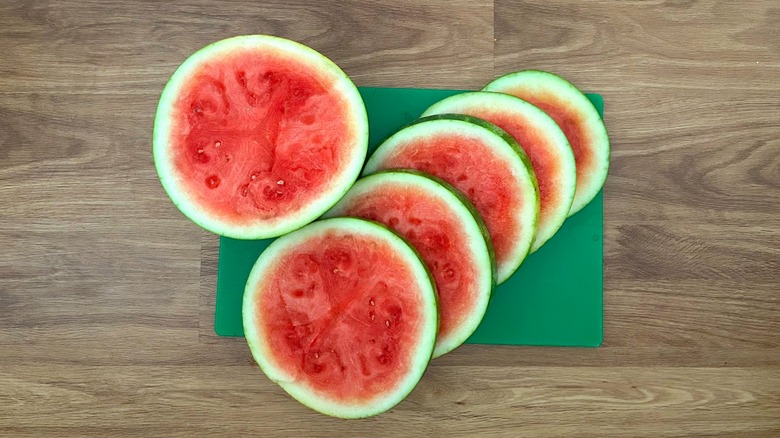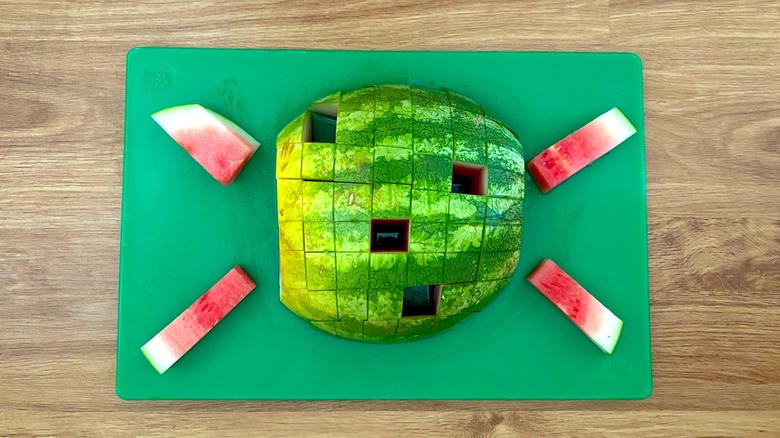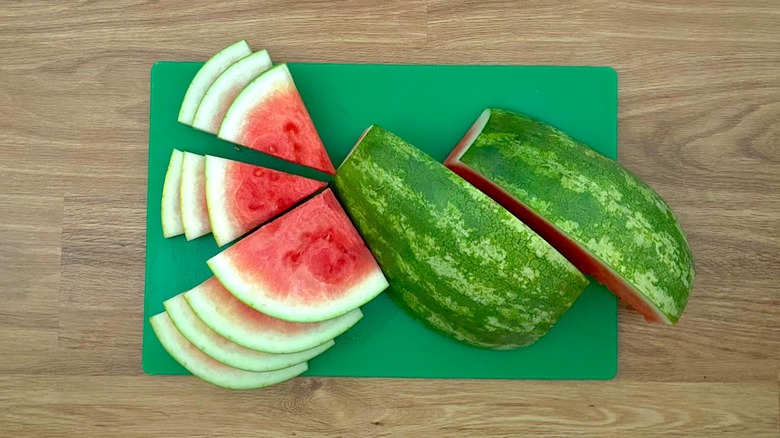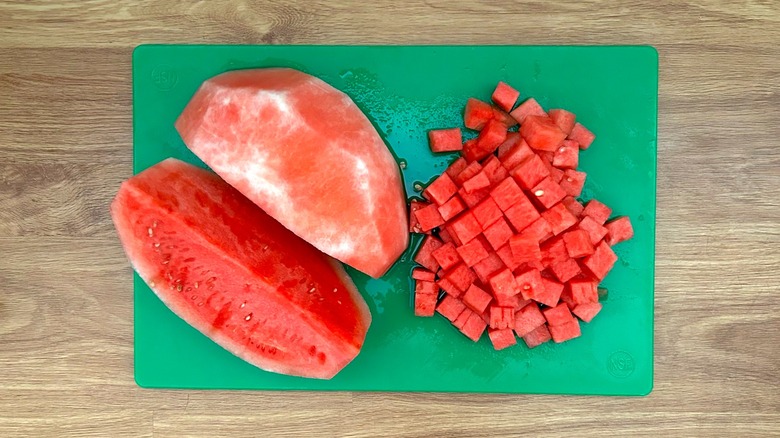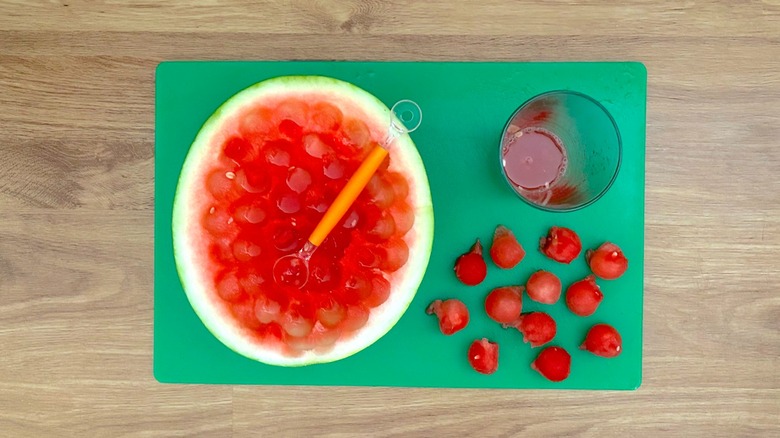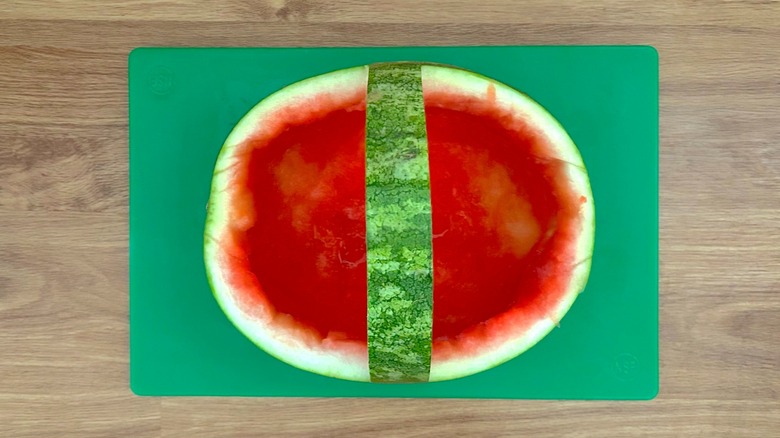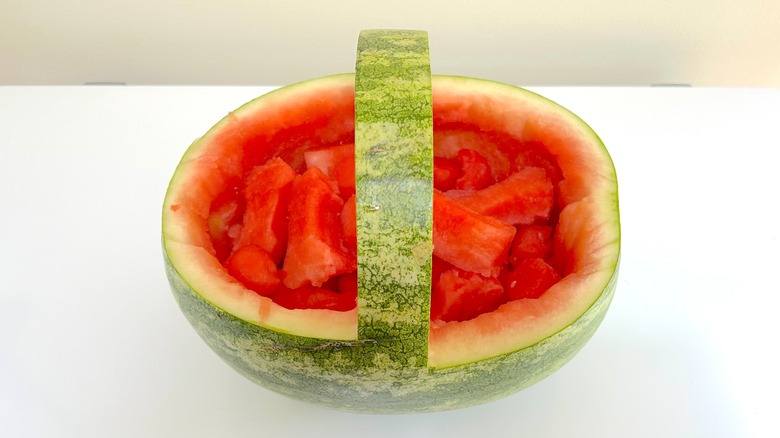We Found The Best And Worst Ways To Cut A Watermelon
We may receive a commission on purchases made from links.
One of the joys of summer is the appearance of fresh watermelon at the grocery store and farmer's markets. Not only is watermelon delicious and refreshing on a sweltering day, it's good for you. While rich in vitamins and minerals, perhaps watermelon's greatest superpower is its capacity to hydrate. Made from 92% water, this fruit is sure to keep your body lubricated so that it's functioning at tip top shape while you enjoy eating that grilled meat and imbibing some of the most epic summer cocktails.
All of this is great, but one of the reasons more people don't indulge in fresh watermelon more frequently is that it can be a huge pain to cut. Its skin is dense, its shape makes it quite dangerous to handle, and you may need to start bodybuilding to wrangle one around without injuring a rotator cuff or throwing out your back.
That said, there are some better and worse ways of cutting a watermelon for both ease and functionality. To help take the guesswork out of it for you, I decided to test seven of these methods. Read on to discover the pros and cons of each of these cutting techniques, ways to make the process less challenging, and some safety tips that can help make your summer gatherings tastier and more fun.
What to know before you start cutting a watermelon
Before you begin cutting a watermelon, there are a few things to keep in mind. First, it can be helpful to know how to pick the perfect watermelon. Among the things to consider are its color, density, and any imperfections to its rind. Once you select the watermelon and get it home, wash it thoroughly to avoid the spread of bacteria into the melon as you cut it — and be sure to dry it with a clean paper towel to prevent slippage.
Next, you'll need to gather your tools. While there are a number of cheap watermelon cubing gadgets available on Amazon, I'd recommend against these. Instead, opt for either a knife with a serrated-edge, like a bread knife, or a very sharp chef's knife. The former is ideal for hacking through the tough rind, especially for cuts where you want to keep the rind intact, while the latter will ensure cleaner cuts, particularly in instances where you plan to remove the rind.
You will also need a clean, dry cutting surface. If you're using a cutting board, place a damp paper towel underneath it to prevent it from moving around. Lastly, keep a stash of paper towels at the ready to sop up any juices that run out of the melon while you're cutting it. This will keep things tidy and will prevent the melon from being too slippery to handle safely.
Worst: Rounds
Perhaps the most straightforward method for cutting a watermelon is to slice it into rounds. The primary reason to use this cutting method would be for making a sweet watermelon pizza recipe. The ideal tool for this method is a serrated knife. To cut a watermelon into rounds, lay it on its side and make crosswise slices that are about 1 inch in diameter.
While I say simply, this process isn't that easy at all, even with a serrated knife. Depending on the size of the watermelon, it can be unwieldy to handle and hard to stabilize. One tip to make this easier is to locate the field spot of the melon. This is the area of the melon that was in direct contact with the ground while it grew. It tends to be lighter in color and somewhat flattened, which can help keep the watermelon from rolling around.
That said, even when using the field spot to secure the melon, this method is hard to execute consistently. I found it difficult to carve through the rind and to keep each slice an even width all the way through. If I use this method again, I would only do so with a smaller watermelon that is simpler to wrangle and has a slightly thinner rind to carve through.
Best: Sticks
One advantage to cutting a watermelon with the rind still intact is that it acts as a de facto serving utensil for the melon, making it easier and less sticky to consume. A fantastic way of cutting a watermelon where its rind remains attached is what is often known as the "grid method." This technique produces watermelon sticks that are ideal for serving at a party. They transform a huge watermelon into a finger food that can be enjoyed with one hand while the other is occupied with a beverage.
To perform this method, you can use either a serrated knife or a chef's knife, though I prefer the latter, as it helps to keep the surface of the flesh of the watermelon smooth. Start by cutting the watermelon in half lengthwise. Place one-half of the watermelon on the cutting board, cut-side down, and carve it into 1-inch sections, first lengthwise, then crosswise. Duplicate this with the other half of the watermelon.
While the rind of the melon is still a bit challenging to cut through and slice consistently without the pieces pulling apart, this method is quick to execute and the result is worth the effort. The pieces are convenient to eat and even easier to store in an airtight container or plastic bag if you plan to cut the melon in advance or take it to-go.
Worst: Wedges
To cut a watermelon into wedges, you can use either a serrated knife or a chef's knife. Again, for clean edges, the chef's knife will be preferable, but the serrated one will expedite things and save you some elbow grease.
There are a couple of ways to cut a watermelon into wedges. You can slice it into rounds first and then cut said slices into quarters or eighths, but I find this to be far too challenging for safety and consistency. I prefer cutting the ends of the melon off and then slicing it in quarters lengthwise first. Then you can cut each quarter into 1-inch thick wedges, which can further be broken down into triangles.
While cutting a watermelon into wedges may have been a preferred technique when I started this experiment, after discovering the "grid method," I'm a convert. If you want to cut a melon while keeping the rind intact, there is no reason to keep it in wedge form. The sticks produced by the "grid method" are infinitely more convenient to eat and somewhat easier to cut.
Best: Cubes
When it comes to safety and ease, any watermelon cutting method where you can dispose of the rind before hacking into the meat of the fruit is going to be preferable to one where the rind remains intact. For this reason alone, cutting it into cubes is a great idea. This is also the preferred method if you are planning on using the melon in a recipe, like a salad, salsa, or a tequila-soaked summer treat.
To cube a watermelon, you'll need a very sharp chef's knife to remove the rind of the fruit. Start by cutting off the tips of the melon. Then place it on its end and carefully score around the edges of the fruit from top to bottom, taking care to remove only the rind while leaving the meat intact. Rotate the watermelon and repeat this process until all of the rind has been detached. Once the rind has been removed, slice the melon into quarters lengthwise and then cut these into cubes of whatever size you prefer.
This process takes some practice, but once you get the hang of it, it's quite easy to execute. And, don't toss those watermelon rinds out after removing them from the flesh of the fruit. These can be pickled and used as a garnish for deviled eggs, tacos, salads, cocktails, and more. They not only lend a great flavor to a dish, but they add textural intrigue.
Worst: Balls
While melon ballers, like this one from the OXO brand, can be useful tools for such tasks as hollowing out a zucchini for stuffing, seeding a pear before poaching it, or shaping dainty meatballs, excavating a watermelon isn't necessarily one of these. Don't get me wrong, it's not that it's hard to do, but it is tedious and not the most utilitarian way of cutting a watermelon.
That said, if you're hell bent on doing so because it's cute, the best way to employ a melon baller with a watermelon is to start by cutting off opposite edges of the fruit to create a flat surface and slicing it in half lengthwise. Then you can simply scoop out balls from each half until you have used up as much of the watermelon as possible.
One downside to this process is that you may end up with some waste, as it can be hard to get perfect balls without damaging some of the watermelon. The upside? Lots of juice. As you scoop out the balls, you will notice the watermelon half filling up with liquid. Don't discard this liquid gold. Not only is it a hydrating and refreshing beverage, it's fantastic for making ice cubes, adding to cocktail recipes, or turning into a frozen treat, like a popsicle.
Best: Shapes
One watermelon cutting method that I especially loved because it was both easy and functional was cutting it into shapes using either a cookie cutter, like these from Ann Clark, or a round biscuit cutter, like these from the HULISEN brand. If you don't have a cookie cutter or biscuit cutter, simply use the lid of a mason jar, like I did, or the rim of a drinking glass.
The technique for this is fairly straightforward. Start by removing the ends of the watermelon and then peel it, as if you're going to cut it into cubes. Once peeled, slice the melon into ½-inch rounds and then use the shape of your choice to cut out pieces of watermelon. Serve these as-is, or as a pro-level cocktail garnish for your favorite summer libation.
Perhaps the only downside to this method is that you will end up with pieces of melon that are technically wasted and are now in odd shapes that aren't especially visually-appealing to serve. These are great to transform into refreshing watermelon slushies or can be frozen for later use. Frozen watermelon is especially well-suited for an instant granita recipe or for making into a blended cocktail, like a margarita or a daiquiri.
Worst: Boat or basket
One watermelon cutting technique that has long intrigued me is transforming it into a boat or basket. I always thought this looked attractive on a buffet, but it seemed too complicated to execute. My hunch was dead-on. It's quite a pain to do, and, frankly, I'm not sure it's worth the effort, unless part of the enjoyment and satisfaction you get from making one is engaging in the artistic endeavor and witnessing a job well-done.
While a serrated knife makes this process infinitely easier, it can shred the watermelon too easily, defeating the purpose of a pretty presentation. Unfortunately, a chef's knife may not be sharp enough or small enough to navigate more complicated patterns. That said, I used one anyway. I started by cutting the base of my watermelon off to create a flat, stable base and then drew guidelines with a sharpie to indicate where to cut the handle and bottom of the basket.
Then I carefully scored the watermelon along the midline and up the handle, creating two triangle pieces that were relatively easy to remove and carve into wedges or cubes. Getting the meat out of the base of the watermelon was another story altogether. While you can score around the edge of the watermelon and scoop out slices of meat, they aren't very consistent or pretty. You are almost better off using a melon baller, and even then you'll have to dig the remaining flesh out to create a clean basket.
What's the best method to cut a watermelon?
Ultimately, the best method to cut a watermelon is one you will actually use and are comfortable with. If you're determined to create something artistic that will wow a crowd, you may find that making a basket or boat is worth the hassle. For my money, it is not. I prefer a method that is far more practical and less wasteful. For this reason, I'd say there are two clear winners for the best way to cut a watermelon, depending upon your end goal: sticks and cubes.
If your goal is to carve a watermelon that's easy to eat as-is for a summer cookout or as a snack for the kids after they get out of the pool, the stick method is the most functional technique. Not only is it quick to execute, it results in little to no waste. It also allows the watermelon to be consumed without a utensil while minimizing the amount of clean up involved. That's a win-win in my eyes.
For recipes, you can't do better than cubing a watermelon after peeling it. Again, the process is rather simple compared with a lot of the others, it's fairly rapid, and there is little to no waste. It also makes seed removal a breeze, although I was able to purchase seedless watermelons, which is always preferable.
